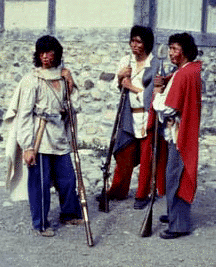
The Amerinds of Cape Breton

Long before Cabot and Cartier Cape Breton was known to its original inhabitants as Unama' Kik. From possibly as early as 3 000 B.C. the Mi'kmaq people, one of the tribes of Algonquin culture, had lived on the island. They were a nomadic people, hunter/gatherers who fished the land, hunted the forests and lived in harmony with nature.
 Around the time of the first European arrivals the Mi'kmaq population is believed to have been between 35 000 and 50 000. During the subsequent years massive numbers of these people, like most American aboriginals, were wiped out, due in part to dietary changes and the introduction of diseases for which they had no immunity. By the 1700s, after almost 200 years of European contact they numbered about 15 000. The Maritime population is estimated to have been about 3 500 with over 600 warriors. When the Louisbourg settlement party arrived in Cape Breton they found around 25 to 30 Mi'kmaq families living on the island and though additional Mi'kmaqs came to the island the population never seemed to exceed 250.
Around the time of the first European arrivals the Mi'kmaq population is believed to have been between 35 000 and 50 000. During the subsequent years massive numbers of these people, like most American aboriginals, were wiped out, due in part to dietary changes and the introduction of diseases for which they had no immunity. By the 1700s, after almost 200 years of European contact they numbered about 15 000. The Maritime population is estimated to have been about 3 500 with over 600 warriors. When the Louisbourg settlement party arrived in Cape Breton they found around 25 to 30 Mi'kmaq families living on the island and though additional Mi'kmaqs came to the island the population never seemed to exceed 250.
Since 1713 the Mi'kmaqs saw there homeland divided into two rival imperial jurisdictions - Great Britain and France. The importance to the French of the fur trade and fishing interfered little in the native way of life and relations between the two were generally friendly. The English on the other hand alienated the nomadic Mi'kmaqs with their emphasis on agriculture and individual land ownership. The aboriginal populace needed mobility and large areas for hunting grounds and the idea of land title was inconceivable.
 With the settling of Cape Breton the French sought to ally themselves with the native population. This allowed them to control a larger territory then would have been possible with only a minimal number of French settlers. This alliance was made easier by the fact that the Mi'kmaqs had long since been converted to the Roman Catholic faith and generally accepted and trusted the French missionaries. The French also treated the native populations as respected and important allies and annually renewed this alliance with festive ceremonies during which gifts were presented by both sides. The Mi'kmaqs would present the French with offerings of wampum, pipes, furs and tobacco and in turn were given fabrics, tools and, most importantly, firearms and ammunition.
With the settling of Cape Breton the French sought to ally themselves with the native population. This allowed them to control a larger territory then would have been possible with only a minimal number of French settlers. This alliance was made easier by the fact that the Mi'kmaqs had long since been converted to the Roman Catholic faith and generally accepted and trusted the French missionaries. The French also treated the native populations as respected and important allies and annually renewed this alliance with festive ceremonies during which gifts were presented by both sides. The Mi'kmaqs would present the French with offerings of wampum, pipes, furs and tobacco and in turn were given fabrics, tools and, most importantly, firearms and ammunition.
The Maritime natives acted as military scouts and guerrilla warriors for the French and some were awarded with military rank and pay. The French encouraged Mi'kmaq attacks on English shipping, fishing bases, and settlements, successfully promoting native hostilities towards the English and hampering English colonial growth. Between 1713 and 1760 at least 80 English ships were captured by the Mi'kmaqs and the English colonials, though outnumbering the natives 3 to 1, were kept constantly on guard.
Despite the special status held by the Mi'kmaqs, their military importance and their Roman Catholic ties to the French, they were separated by the differences in their culture, economics and language. Although parish records of births and baptisms indicate that family groups visited Louisbourg occasionally few natives, aside from some Panis slaves, lived within the town. Surgeons were paid to care for natives in such outlying colonies as Port Toulouse but Mi'kmaqs were not allowed admittance to the Louisbourg hospital and intermarriage, though it often occurred, was actively opposed by Louisbourg officials.
The Mi'kmaqs fought for the French during both sieges as scouts, messengers, coastal lookouts and auxiliary soldiers. Their effectiveness had been well proven but unfortunately the bands were ill-used during the struggles. After the fall and destruction of Louisbourg, though the Mi'kmaqs remained friendly with the remaining French-Acadians and adhered to the Roman Catholic faith, they were abandoned by the French and left to deal with the English.


